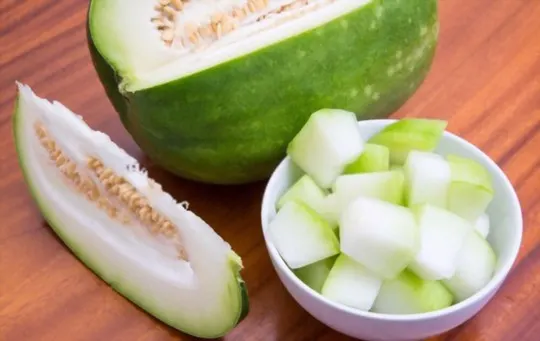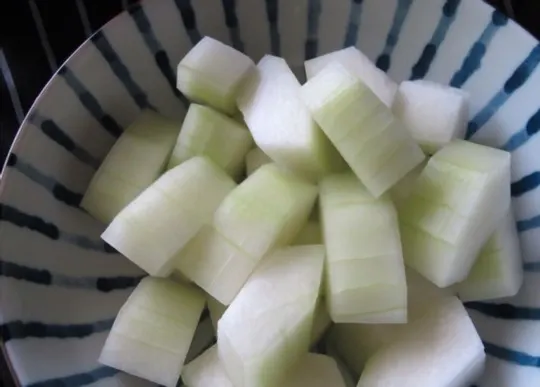Ever scratched your head at the sight of a winter melon?
This unique gourd might just be your next kitchen favorite.
Often overlooked, winter melon is like nature’s gift to those looking to add a twist to their meals.
Mild yet versatile, it can soak up flavors like a sponge, making it a fantastic addition to soups, stews, and even drinks.
Ready to uncover the subtle yet intriguing taste of winter melon?
Join us as we slice into its culinary potential and discover what makes this melon stand out in any dish.
What is Winter Melon?

It’s a fruit native to South and Southeast Asia but consumed as a veggie.
It also goes by several names, which we will mention later.
It belongs to the family of Cucurbitaceae, and it’s the sole member of the genus Benincasa.
When young, the winter melon has a hairy coating that goes away as it matures, giving way to a waxy coating or a powdery ash coating.
It grows up to 80cms and has a long shelf life.
Though it doesn’t grow in all of Asia, it’s eaten throughout the continent.
Every region has a special dish comprising of winter melon.
While it’s popularly consumed as a vegetable, it has been recognized as a medicinal plant in India since ancient times, as documented in Ayurvedic texts.
The leaves, shoots, and tendrils of the plant are all edible and delicious.
You can cook the fruit along with them to create lovely and nutritious dishes.
What Does Winter Melon Taste Like?

Winter melon is one of those fruits/veggies which you can cook and use in many ways, as you found out earlier.
It’s both tasty and nutritious, and that’s why it’s so popular.
It’s also one of those ingredients which go by many names.
It’s called ash gourd, wax gourd, white gourd, ash pumpkin, white pumpkin, winter gourd, tallow gourd, alu puhul, or Chinese preserving melon.
When ash gourd is young, it tastes sweet and very similar to cucumber.
The sweetness fades a little when it reaches maturity, with the fruit tasting juicier and crispy.
However, it still retains its unique flavors, which are pretty mild.
Winter melon tastes delicious whether you cook it alone or with other ingredients.
Adding spices and seasonings can enhance a dish even more as it absorbs the flavors.
- Taste of Raw vs. Cooked Winter Melon.
When eaten raw in salads, it refreshes your palate as it’s crunchy and juicy, and you experience a burst of amazing flavors.
Hence, it can be an excellent option to have when you have a rich and filling meat dish with loads of fats and spices.
When cooked, it retains its flavors and juiciness, but it becomes softer.
It will also taste different than the raw one if you add spices and herbs in the cooking process.
- Nutritional Value of Winter Melon.
Wax gourd or winter melon has low calories, with 100g containing only 13 calories, almost equivalent to cucumbers of the same weight, which have 12 calories.
It also has several vitamins, fiber, and minerals.
It’s also gluten-free and, therefore, a suitable food item for those who are gluten intolerant.
How to Cook Winter Melon?

Even the peel is nutritious, so you might want to cook a dish out of it.
Winter melon peel contains a good amount of dietary fiber, ensuring smooth bowel movement.
There is no one best way to cook and serve winter melon because all are good.
You can cut tender wax gourd into slices or cubes and add them to salads.
It adds a crispy and fresh texture to your dish.
You can also add chunks of ash gourd to soups and stews, which have braised pork belly sprinkled with spring onions.
Or you can make yummy curries the Indian way.
You name it: pudding, casseroles, cakes, halwa, and candies.It’s suitable for all these dishes.
An Indian candy called petha is simple and sweet but is a ‘crazy sweet burst in the mouth.’.
Don’t throw away the seeds. You can toast them in the oven and munch them like you do pumpkin seeds.
They make healthy and tasty snacks.
If you love cucumber juice but don’t have the fruit/veggie, you can make an excellent juice out of a wax gourd.
Add some ice to make it chilled.
Conclusion
Winter melon is still an unknown delicacy in many places.
But now you have an idea about its taste and ways to cook and eat it.
So, the next time you visit a farmer’s market or the grocery store, grab a few and give it a try.
There are numerous recipes for the fruit/veggie, so you have plenty of choices.
Since you can make juice, sweet and savory dishes out of it, it might take some time before you finally decide which dish you like most.

What Does Winter Melon Taste Like? Does Winter Melon Taste Good?
Ingredients
- Winter melon
- Ingredients from your favorite recipes
Instructions
- Depending on the ingredients used, the cooking method, and the type of dish, the taste of the food can vary greatly.
- Make sure to select a recipe that will elevate the food’s original flavor, and enjoy experimenting with different recipes!

Andrew Gray is a seasoned food writer and blogger with a wealth of experience in the restaurant and catering industries. With a passion for all things delicious, Andrew has honed his culinary expertise through his work as a personal chef and caterer.
His love for food led him to venture into food writing, where he has contributed to various online publications, sharing his knowledge and insights on the culinary world. As the proud owner of AmericasRestaurant.com, Andrew covers a wide range of topics, including recipes, restaurant reviews, product recommendations, and culinary tips.
Through his website, he aims to inspire and educate fellow food enthusiasts, offering a comprehensive resource for all things food-related.

Leave a comment